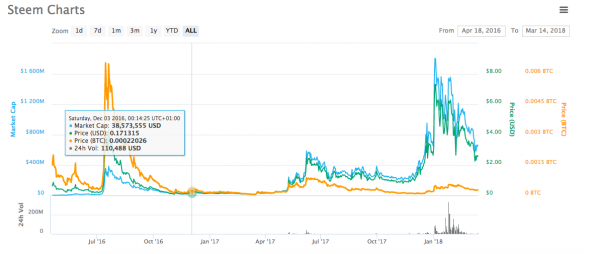Steemit :How Does It Work and Can You Really Earn From It?
The mind offspring of Daniel Larimer, pioneer behind BitShares, and Ned Scott, a previous monetary investigator, Steemit is a blockchain-based web-based entertainment stage displayed freely on Reddit.

Any individual who utilizes Reddit knows that content lives and kicks the bucket with the sacrosanct upvote (or downvote). Upvotes bring "karma," more prominent perceivability, and, surprisingly, the possibility arrival on the first page.
Also, Steemit clients are competing for upvotes, however this is on the grounds that commitment and consideration lead to genuine monetary award. Steemit rewards clients for posting, remarking, and, surprisingly, simply upvoting other substance. Rewards are paid in the stage's local digital currency, STEEM.
To depict it utilizing their own words:
Steemit has re-imagined virtual entertainment by building an authentic, and developing social economy - a local area where clients are compensated for sharing their voice. It's another sort of consideration economy.
Steemit has been around since July 2016, it has countless clients, and it's as of now the 27th greatest cryptographic money by market cap.
However there doesn't appear to be a very remarkable decision on this stage (from a wide perspective). In this article, we evaluate the stage on how it functions, how to utilize it and on the off chance that you can truly bring in cash from Steemit.
-How Steemit Works
.png)
Steemit, Inc. is a secretly held organization situated in New York City. So behind this blockchain stage is a privately owned business, not an arbitrary gathering of engineers as is many times the situation. Contrasted with a portion of its blockchain bretheren, Steemit is somewhat basic.
Steemit.com is just a single stage for web journals and web-based entertainment content that sits on the Steem blockchain. There are different stages that utilization the equivalent blockchain and basic financial instruments. An illustration of this is D.tube, a decentralized video stage in light of the InterPlanetary File System convention. D.tube is YouTube without the promotions (and client base) - all things considered, it utilizes the inherent Steem cash to remunerate content makers. D.sound is another model, for this situation for sound streaming.
The whole Steem framework is based on secure blockchain programming that sudden spikes in demand for an organization of PCs. At the base of the stage is the money STEEM, which is your run of the mill transferrable, fungible, unreservedly moveable token (like bitcoin). The money comes in 3 variations.
1.Steem (STEEM) - Steem is the essential unit of record on the Steem blockchain. Any remaining tokens get their worth from the base worth of STEEM. STEEM is fluid and can be looked for, sold, or traded in any capacity a holder sees fit. STEEM can be changed over completely to both Steem Power and Steem Dollars. Transforming STEEM into STEEM Power is alluded to as "driving up." The ongoing expansion pace of STEEM is 9%, and it will diminish by 0.5% consistently until the rate comes to 0.95%.
2.Steem Power (SP) - STEEM that has been focused on a 13-week vesting plan is alluded to as Steem Power (SP). SP has a 2-pronged expectation; it makes a motivation component where holders take a drawn out revenue in the task, and by having Steem Power it builds a record's democratic weight (and likewise its capacity to be additionally compensated). A shared benefit for the two clients and for the environment as entirety. SP is illiquid, and it tends to be considered organization value. Whenever a client chooses to change over SP back into STEEM, it is alluded to as "shutting down."
3.Steem Dollars (SD) - SD are an obligation like instrument, fixed to the US dollar, that guarantee to circulate US$1 worth of STEEM per SD to the symbolic holder sooner or later. You can exchange Steem Dollars with STEEM, or move them to different records for business or trade. The point here is to give a vehicle to loan the local area cash and, eventually, to encourage development.
The Steem blockchain is reliably stamping new STEEM tokens and adding them to a local area "rewards pool." The STEEM is then granted to clients for their commitments, in light of the votes that their substance gets. Make important substance and get compensated, so the hypothesis goes.
With each new block, 15% of the new STEEM units are granted to individuals who hold Steem Power, 75% are given off to content makers, and 10% of the new Steem units are paid to diggers.
At the point when you make content that really brings in cash, half is paid to you in Steem Dollars that can be traded for genuine cash immediately. The other half is paid in Steem Power. The Steem Power Units are secured in the vesting time frame referenced previously.
The expression "printing" could have made you consider cryptographic money mining or manufacturing processes, similar to ones found on numerous other blockchains. STEEM is a mineable money, yet it's not the essential approach to procuring tokens.
Delivering or communicating with content on Steemit is the principal way for clients to get STEEM. You can, obviously, likewise buy Steem on a trade or procure interest (a tiny sum) by holding SP.
The Steemit stage has developed massively since its initiation. This is the way the traffic on Steem filled somewhat recently, as per Alexa's web positioning:

Might You at any point Really Earn on Steemit?

Now that we've perceived the fundamentals of how Steemit capacities, the following inquiry is: does it work from a substance maker's viewpoint? The short response is indeed, yet there's something else to it besides that.
Before we dig further into Steemit's legitimacy as a substance stage or speculation vehicle, it's significant there are some question marks with respect to Steem's send off. One article claims that the underlying conveyance cycle of tokens was manipulated and that Steem isn't genuinely a decentralized organization (Dash, anybody?). Whether this is valid remaining parts far from being obviously true - read the article and reach your own inferences.
In spite of the ostensibly problematic nature of a portion of its set of experiences, Steemit is in no way, shape or form a temporary activity or a trick. It is working and individuals are getting compensated. The inquiry is the way in which well is it working? Are clients happy with it?
The solution to these inquiries appears to rely upon who you inquire. One creator professed to have made around what might be compared to $2,300 in around 4 months:
Out of 230 articles approximately 5 had any important returns, none of which offset the expense to keep in touch with them. They likewise have a timeframe of realistic usability up to a tweet [… ] I must give Steemit a 'D' for content makers. There's much more you could achieve on your own site significantly quicker, different stages are more hearty with more grounded adaptation, more grounded apparatuses, more assets for those new to the local area.
So there are episodic pieces for proof pointing in the two headings, how might we figure out this? You can continuously attempt it for yourself or investigate the essential elements in play.
Beginning without any preparation on Steemit is without a doubt a test. The chances of naturally growing a following on the rear of just quality substance is a remote chance that requires a lot of exertion forthright
Putting resources into STEEM

After Steem's underlying send off, individuals immediately warmed to the thought. The STEEM token saw a huge lift in cost, contacting a market capitalization of nearly US$400 million in mid-July 2016.
However, the blast in ubiquity featured various blemishes in the framework, to be specific that a couple of whales controlled such an excess of Steem Power that they had practically limitless command over what content got compensated (by and large, their own).
This hurried climb and resulting openness of deficiencies (in addition to other things) prompted the cost of STEEM failing. This pattern didn't turn around itself until mid-2017, when Steem got a portion of the energy from crypto's traveling rise last year (as the graph above shows). Ascending from its low of around $.07, STEEM at present expenses $2.01, and whether this is a wise speculation really relies on how you see the stage.
On the off chance that you become involved with the cynics' and pundits' perspective, you don't see a very remarkable future for Steemit. You don't predict a spike popular for STEEM tokens, and in this way you'll likely ignore it practically paying little heed to cost.
Assuming you view Steemit as a stage that will disturb every single social medium, then purchasing something similar to stock for $2.01 should have been visible as a flat out take.